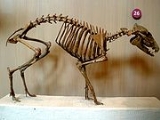
Hypertragulus
Encyclopedia
Hypertragulus is an extinct genus belonging to the family
Hypertragulidae
, within the order Artiodactyla, endemic to North America
during the Eocene
to Miocene
, living , existing for approximately .
Hypertragulus were primitive and ancient ruminant
s, resembling small deer
or musk deer
, although they were more closely related to modern chevrotain
s. Its diet is stated to be that of a frugivore
.
Family (biology)
In biological classification, family is* a taxonomic rank. Other well-known ranks are life, domain, kingdom, phylum, class, order, genus, and species, with family fitting between order and genus. As for the other well-known ranks, there is the option of an immediately lower rank, indicated by the...
Hypertragulidae
Hypertragulidae
Hypertragulidae is an extinct family of even-toed ungulates , endemic to North America, Europe, and Asia during the Eocene through Miocene, living 46.2—13.6 Ma, existing for approximately ....
, within the order Artiodactyla, endemic to North America
North America
North America is a continent wholly within the Northern Hemisphere and almost wholly within the Western Hemisphere. It is also considered a northern subcontinent of the Americas...
during the Eocene
Eocene
The Eocene Epoch, lasting from about 56 to 34 million years ago , is a major division of the geologic timescale and the second epoch of the Paleogene Period in the Cenozoic Era. The Eocene spans the time from the end of the Palaeocene Epoch to the beginning of the Oligocene Epoch. The start of the...
to Miocene
Miocene
The Miocene is a geological epoch of the Neogene Period and extends from about . The Miocene was named by Sir Charles Lyell. Its name comes from the Greek words and and means "less recent" because it has 18% fewer modern sea invertebrates than the Pliocene. The Miocene follows the Oligocene...
, living , existing for approximately .
Hypertragulus were primitive and ancient ruminant
Ruminant
A ruminant is a mammal of the order Artiodactyla that digests plant-based food by initially softening it within the animal's first compartment of the stomach, principally through bacterial actions, then regurgitating the semi-digested mass, now known as cud, and chewing it again...
s, resembling small deer
Deer
Deer are the ruminant mammals forming the family Cervidae. Species in the Cervidae family include white-tailed deer, elk, moose, red deer, reindeer, fallow deer, roe deer and chital. Male deer of all species and female reindeer grow and shed new antlers each year...
or musk deer
Musk deer
Musk deer are artiodactyls of the genus Moschus, the only genus of family Moschidae. They are more primitive than the cervids, or true deer, in not having antlers or facial glands, in having only a single pair of teats, and in possessing a gall bladder, a caudal gland, a pair of tusk-like teeth...
, although they were more closely related to modern chevrotain
Chevrotain
Chevrotains, also known as mouse deer, are small ungulates that make up the family Tragulidae, the only members of the infraorder Tragulina. There are 10 living species in three genera, but there are also several species only known from fossils...
s. Its diet is stated to be that of a frugivore
Frugivore
A frugivore is a fruit eater. It can be any type of herbivore or omnivore where fruit is a preferred food type. Because approximately 20% of all mammalian herbivores also eat fruit, frugivory is considered to be common among mammals. Since frugivores eat a lot of fruit they are highly dependent...
.
Morphology
One specimen of Hypertragulus examined for body mass by M. Mendoza, C. M. Janis and P. Palmqvist had a mass of 7.29 kg (16.1 lb).Fossil distribution
A partial list of fossil sites:- Chihuahua, MexicoChihuahua, MexicoChihuahua, Mexico, may refer to:* The State of Chihuahua in Mexico* The City of Chihuahua, Chihuahua, its capital...
- Cedar Creek Formation (Lower & Middle), Logan County, ColoradoLogan County, ColoradoLogan County is the 23rd most extensive of the 64 counties of the State of Colorado of the United States. The county was named for General John A. Logan. The county population was 20,504 at U.S. Census 2000. The county seat is Sterling...
- Fort Logan Formation, Meagher County, MontanaMeagher County, Montana-National protected areas:*Gallatin National Forest *Helena National Forest *Lewis and Clark National Forest -Demographics:As of the census of 2000, there were 1,932 people, 803 households, and 529 families residing in the county...
- Upper Pomerado Conglomerate Formation, San Diego County, CaliforniaSan Diego County, CaliforniaSan Diego County is a large county located in the southwestern corner of the US state of California. Hence, San Diego County is also located in the southwestern corner of the 48 contiguous United States. Its county seat and largest city is San Diego. Its population was about 2,813,835 in the 2000...
- Turtle Cove Member of the John Day Formation, Grant County, OregonGrant County, OregonGrant County is a county located in the U.S. state of Oregon. It is included in the 8 county definition of Eastern Oregon. In 2010, its population was 7,445. It is named for President Ulysses S. Grant, who served as an army officer in the Oregon Territory, and at the time of the county's creation...

